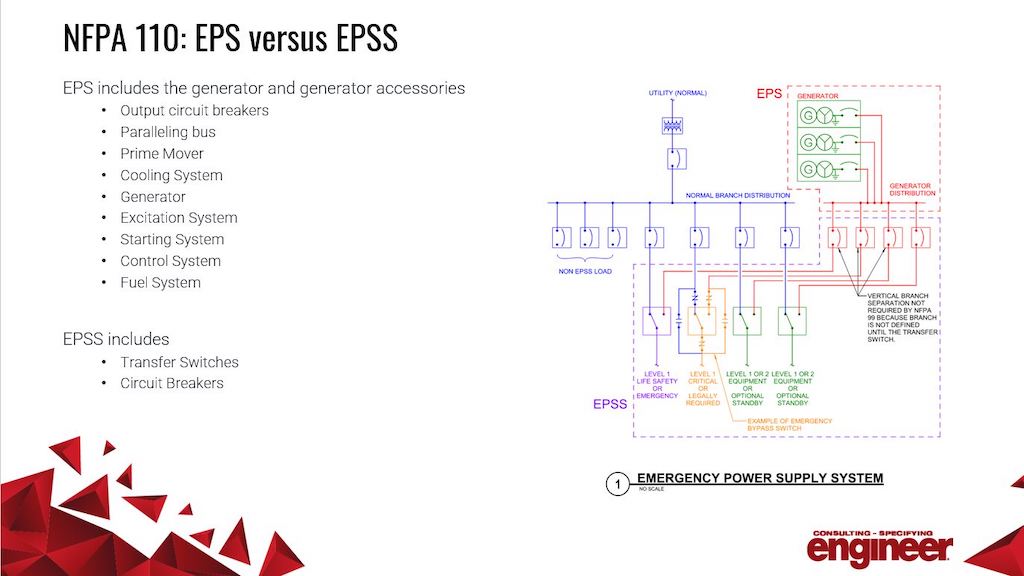
Image courtesy: Brett Sayles
EPS insights
- Emergency power supplies (EPS) and emergency power supply systems (EPSS) are vital in emergency and standby power systems.
- The 2022 edition of NFPA 110: Standard for Emergency and Standby Power Systems covers performance requirements for emergency and standby power systems providing an alternate source of electrical power in buildings and facilities in the event that the normal electrical power source fails.
Mission critical facilities nearly always need some sort of backup power systems. Having a full understanding of NFPA 110: Standard for Emergency and Standby Power Systems requirements starts with familiarity with the following emergency power system components:
- ATS: automatic transfer switch.
- EPS: emergency power supply.
- EPSS: emergency power supply system.
Engineers also are required to understand Level 1 EPSS, Level 2 EPSS and mission critical systems.
During the critical power webcast, NFPA 110: Standard for Emergency and Standby Power Systems, the presenters were asked several questions about EPS and EPSS, several of which are answered here.
Expert presenters:
- Richard Vedvik, PE, senior electrical engineer and acoustics engineer, IMEG Corp., Rock Island, Illinois.
- Tom Divine, PE, senior electrical engineer, Johnston, LLC, Houston.
Can you review the colocation of Emergency Power Supply System (EPSS) and normal service equipment again? Is normal service equipment considered to be only that fed directly from a utility?
Tom Divine: Service equipment is defined in the NFPA 70: National Electrical Code (NEC), Article 100, Definitions, as, “The necessary equipment … connected to the serving utility and intended to constitute the main control and disconnect of the serving utility.” The phrase, “normal service equipment,” applies only to equipment that’s connected to the utility. It’s acceptable to install EPSS equipment, other than the Emergency Power Supply (EPS) itself, in the same room with other components of the normal power system.
Is it OK to have only two branches of EPSS at a facility instead of the following three: NEC Article 700, 701, 702?
Richard Vedvik: Yes, some buildings may only require Article 700 loads while others may be a combination of the three. The informational notes for each article describe the types of loads to be connected on each branch.

NFPA 110 outlines the difference between an EPS and EPSS. Courtesy: Consulting-Specifying Engineer
If my EPS is located outside does the EPSS need its own room inside or be in an electrical room without the switchboard?
Richard Vedvik: NFPA 110 Ch. 7.2.3 identifies separation of normal service equipment (i.e., NEC Article 230) from being in the same room as Level 1 EPSS if the normal service equipment is >150V to ground and >= 1000A. The commentary on Ch 7.2.3 explains this specific restriction. A dedicated room for EPSS is not required as other distribution components are allowed.
How does the need for a portable or temporary power source per 700.3 (F) affect the design of an EPSS and what does this include the fire pump?
Richard Vedvik: The design is affected by the real estate required to execute the temporary connection, given the connection to the generator set or electrical distribution and the mechanical protection to prevent paralleling of the permanent and temporary generators.
A fire pump transfer switch, if served by the permanent standby EPS, would also be served by the temporary EPS.
I have been hired to install a generator to the existing power distribution system of a library. The quick and easy route to take would be to put an ATS outside and generator outside and reroute the feeder of the main switchboard to the output of the ATS. Based on the information you provided I cannot do this, because I have to separate emergency loads from nonemergency loads? What if the AHJ considers all loads as emergency? 480 V, 3-phase, Wye, 1 MVA.
Richard Vedvik: While I cannot comment on your exact project, note that the classification of the EPS and EPSS is what determines the system design. If a building already has battery backup of emergency loads and a generator is being added in an optional standby classification, then it’s possible that an AHJ would not consider the generator an EES. See also: NEC Article 700.4(C).
What year does the code start requiring the separation of EPS and EPSS from normal equipment?
Richard Vedvik: Section 7.2.3 predates the 2010 edition of NFPA 110.
EPPS components can be in the same room as normal service equipment when rated less than 100 amps AND less than 150V phase to ground, such as a 208V 3-phase system?
Richard Vedvik: Assuming you meant 1000A, then yes, that is what NFPA 110 Ch. 7.2.3 says.
The post "Your questions answered: EPS, EPSS in NFPA 110" appeared first on Consulting-Specifying Engineer








0 Comments